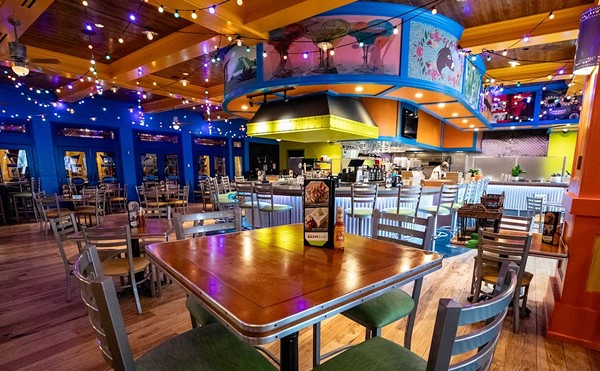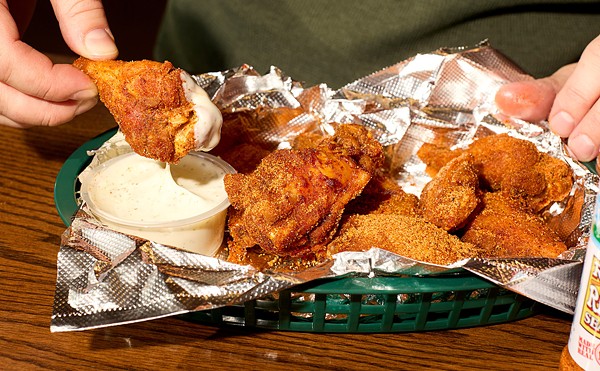Known to have practically invented the art of gastronomy, the ancient Chinese aristocracy were the original foodies. While the Spartans were whuppin' Pericles' butt back in the cradle of democracy (trashing priceless olive orchards in the process), Confucius -- himself an epicure two centuries before Epicurus was born -- was espousing enlightened gourmandise as a foundation of spiritual development. According to his Analects, not only must one avoid eating "anything discolored or that smells bad," one must eschew "what is overcooked, what is undercooked, anything that is out of season, or what has been crookedly cut or lacks proper seasoning."
From this sound philosophy evolved a cuisine so refined that intrepid Venetian merchant Marco Polo hardly minded making the longish drive for the first-ever Chinese takeout (from Venice to Kublai Khan's crib was a matter of three arduous years). For two decades he could not tear himself away from such delicacies as barbecued owl, donkey and camel hump. When at last the traveler returned to Italy with the riches of the Orient, Eastern culinary practice would begin to emerge as a global force; Europe would have noodles, rice and black pepper, not to mention the far-reaching implications of soybeans or the socio-economic impact of tea.
China is home to a billion people and hundreds of ethnic groups, and few Americans are intimate with the zillion regional intricacies that make up the culinary entity we allude to as "Chinese food." Still, its influences have generically permeated the American diet to the extent that things called "chicken stir-fry" are available in frozen form at Shop 'N Save, and one of our households fires up a wok on a weekly basis.
In China, restaurants have existed since the 12th century, 500 years before the same idea would cross a European mind. Fortunately, the notion eventually migrated to this side of the Mississippi; one of the local strongholds of Chinese culture can be found on University City's Olive Boulevard. Countless bakeries and grocery stores, Chinese-language newspapers, lots of chop-suey takeout joints and a bunch of sit-down restaurants dot the strip-mall landscape. After a few expensive but unsatisfying encounters with what has become known as "Asian-fusion" cooking, I find I must revisit a couple of Olive's restaurants to confer on my yearning soul a taste of the genuine (if slightly Americanized) article.
My first stop is Lee's, U. City's venerable purveyor of classic Cantonese cuisine. No St. Paul sandwiches here. In the U.S., Cantonese is regarded as China's haute cuisine and until recently was the style most often associated with Chinese cooking. Fried rice, baby.
We don't order fried rice, though. We order fried water dogs. I've never found out how this savory tidbit acquired its quaint moniker, but it doesn't matter; in the way that only a well-honed Chinese appetizer can, the fried water dog completely satisfies the snootiest epicure's junk-food craving. Triangles of crisp pastry filled with shrimp and pork are engaging yet small enough that you don't mind wolfing down a couple or three before the main courses arrive. We dunk ours in a mixture of hot mustard and duck sauce (heavy on the mustard), with excellent results.
More epic in scope is the fried egg roll. The size of an immodest burrito, it is overstuffed with peppery shredded pork and an abundance of mung-bean sprouts. No small mouthful, it would make a fine -- if slightly greasy -- lunch all by itself.
But why stop there? It's senseless to pass up an opportunity to wrap the lips around a few potstickers, which are possibly China's greatest contribution to Western civilization outside of porcelain. Lee's are a beautifully executed version of this delicacy -- crescent-shaped dumplings filled with a delicious ground-pork mixture, burnt on one side and buttery on the other. These are at their pinnacle when doused with soy sauce and rice vinegar (heavy on the vinegar).
Our benign and gracious server appears to hover effortlessly with about a 100 metal dishes. She sets each one down on the pink tablecloth, teasingly lifts its cover and announces its contents (a practice I heartily endorse both for its dramatic effect and its memory-jogging value). Of these, one that causes a gurgle of joy to erupt in my throat is the green-onion pork. This moo-shu-like dish is meant to be spooned into delicate paper-thin pancakes ("Peking doilies"), which you roll up into a sort of taco and eat with your hands. Watch it, though; if you're as clumsy as I am, you'll tear your pancake and the whole thing will end up in your lap.
I have high hopes for the Mongolian beef, one of my all-time favorite Chinese-American dishes, but Lee's version, though far from inedible, is a minor disappointment. Served on a bed of fried rice noodles, the sliced meat is tired and limp, a little greasy and very salty.
Another dish I don't much love is the shrimp subgum. I will probably never write an ode to the white, glutinous sauces one so often finds menacing the seafood in Chinese restaurants; they glisten but are almost universal in their stupefying blandness. This case is no exception; the ingredients themselves -- almonds, water chestnuts and celery -- are a crunchy foil for the shrimp, but my spirit is a good deal reduced by that glum, poky sauce.
Fate, sensitive to my suffering, bolsters my flagging palate with a dish of green-pepper chicken. Bite-size boneless chicken chunks and bright, crisp bell pepper are courted by a perfect garlicky brown sauce with a wonderful afterburn. This dish does not fail to fascinate and quickly becomes our hands-down favorite.
My work at Lee's is done; I shift forthwith a couple of blocks east to Shu Feng. Anyone who's been here will report having been bullied by the cantankerous proprietress, but do not let this dissuade you. Hers is a benevolent spirit, and besides, the reddening expression of chagrin on your friend's face when his improperly deployed chopsticks are slapped out of his hand is priceless.
Of course, the real reason to darken the stoop of this tiny storefront is the food. Strictly speaking, Shu Feng is a Korean depot, but in addition to a few dozen Korean-style specialties (the red-hot kimchi fried rice is aces, and I double-dare you to try the braised sea cucumber), they've got gorgeous versions of all the usual Chinese suspects. In these I now indulge with the abandon of one who is celebrating her last night on earth.
The hot-and-sour soup here is thick, woodsy and gloriously sustaining, but tonight I'm trying something lighter, the spinach bean-curd soup. Leaves of fresh spinach and tofu cubes float in a piping-hot clear stock; it leaves nearly the same cleansing impression as miso broth.
And the hits just keep on coming. The potstickers are gingery, the egg rolls are crispy, the fried wontons are crackly little bits of savory nothings. These are more than mere appetizers -- they're the culinary embodiment of the block-long floating dragons and pentatonic zither music at Chinese New Year.
There's nothing any too subtle about the eggplant, either. Battered, crisp-fried planks of the vegetable are dripping in a sweet and tingly hot sauce -- the effect is shamelessly tawdry, almost depraved in its excess. Ditto the crispy shrimp; also deep-fried, this dish is infused with "house spicy sauce," a syrupy, blood-red concoction dotted with those fiery little chiles that would make you cry out in alarm if they hadn't already melted your tongue.
If chiles scare you, order it anyway and just pick them out.
But I just can't get a break with Mongolian beef today. Here at Shu Feng, as it was at Lee's, the dish is flawed. The problem is not with the meat, which has perfectly crisped edges and is spiked abundantly with tasty scallions. It's the sauce. I remember a lighter, more virtuous version of this wonderfully garlicky stuff, but since my last visit it has apparently fallen victim to a sinister unctuousness I find difficult to forgive.
Fortunately, all is not lost. The brilliant glow given off by a dish of shredded pork and crispy vegetables with hot garlic sauce lights my way to salvation. We've also selected the Korean version of an old standby, hot braised chicken. These wings in a tangy pinkish sauce -- hot peppers again included -- display greater nuance than the usual sweet-and-sour treatment.
Of course, the wings are not boneless, and the absence of knives, typical of Chinese restaurants, calls certain points of etiquette into question. In the end I opt for the hands-on method and afterward nip through the kitchen to the bathroom, where I hose myself down, contented.
LEE'S CHINESE RESTAURANT, 8613 Olive Blvd., 997-1218. Hours: lunch 11:30 a.m.-2:30 p.m. Tue.-Fri.; dinner 5-9 p.m. Tue.-Sun. Entrees: $5-$9.95.
SHU FENG, 8435 Olive Blvd., 997-7473. Hours: 5-10 p.m. Wed.-Mon. Entrees: $6.95-$14.95.





